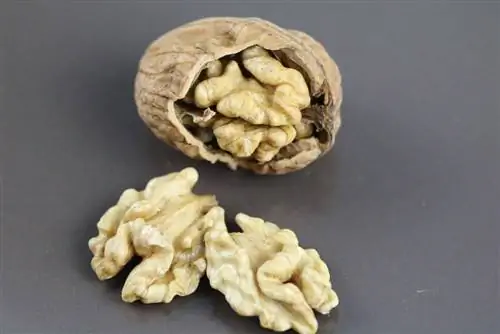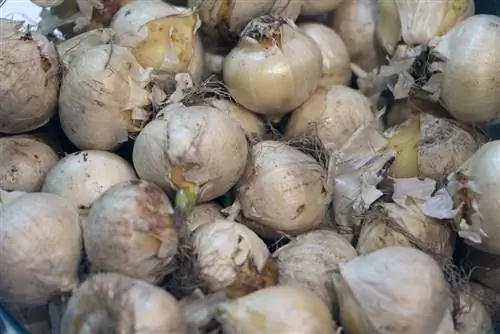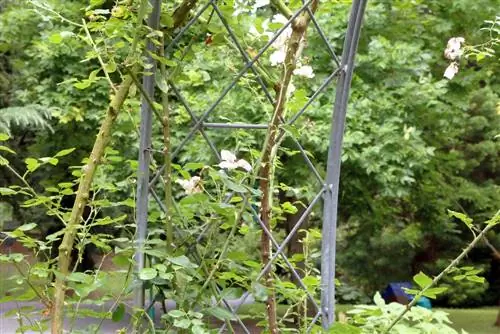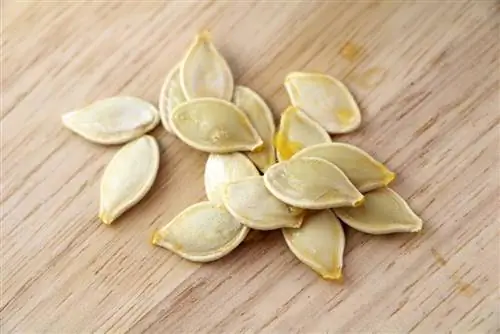- Author admin [email protected].
- Public 2023-12-17 03:39.
- Last modified 2025-01-24 12:45.
From harvesting to storing walnuts, a lot can go wrong. Even small mistakes and carelessness can result in the nuts becoming inedible. We have summarized in this article what hobby gardeners should consider, from harvesting to storage!
Walnut harvest time
As a rule, hobby gardeners can look forward to the walnut harvest from the second year after planting. The nuts themselves take a while to ripen, as the harvest time usually begins at the end of September. However, this is only a guideline because the walnuts should be left on the tree for as long as possible. And that even if the temperatures temporarily drop below 0 degrees. Walnuts cope well with early frost, so they can fully ripen on the tree without any problems. You can tell whether the nuts are ripe by these characteristics:
- green shell bursts open
- Outer shell becomes black
- Fruits fall from the tree
How are walnuts harvested?
The basic rule is: never pick the nuts by force. On the one hand, the shoots could be injured by being torn off. On the other hand, the fruits are not yet ripe. Because mature specimens fall off the tree, so they just have to be picked up - and should be. The nuts land on the sometimes damp ground, which exposes them to moisture. This can penetrate through the shell into the nut and thereby promote mold. It is therefore advisable to pay attention to the following when harvesting walnuts:
- best to collect daily
- especially on rainy days
- dispose of damaged, rotten and moldy nuts
- not in the compost, but in the organic waste bin
Tip:
During the walnut harvesting season, it is an advantage to keep the grass under the walnut tree as short as possible. This makes it easier to identify and collect the nuts on the ground.
After harvest: cleaning walnuts
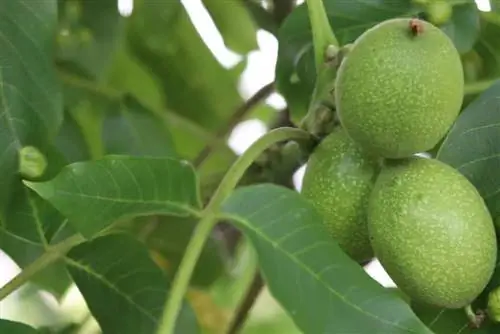
In terms of taste, fresh nuts are the most convincing, which is why they are often eaten fresh. However, before the nuts are eaten, the thin, white skin should always be removed. Because it tastes quite bitter and therefore distorts the taste of the walnuts. However, if you want to dry and store the nuts, you have to clean them first. But be careful! Walnuts are never washed with water, but are only subjected to dry cleaning:
- Peeling nuts with your hands
- Remove peel residue with a coarse brush
- If necessary, dry nuts with kitchen paper
Tip:
It is advisable to always wear gloves during cleaning. The peel contains tannic acid, which causes unsightly brown discoloration on the hands. In addition, it is quite stubborn and often lasts for up to 7 days.
Drying walnuts properly
After the walnuts have been cleaned, they can then be dried. The following applies: The nuts should dry as quickly as possible, but not too quickly. An oven, for example, is not suitable for this because it is simply too hot. Temperatures above 30 degrees affect the fat in the nuts and cause them to go rancid more quickly. It is therefore better to dry the nuts gently. All you need is a flat box that is lined with burlap or an old towel. To dry the nuts, proceed as follows:
- Place nuts generously
- sufficient distance from each other
- all nuts evenly surrounded by air
- Place the box in a dry, airy and dark place
- for example boiler room or attic
- Temperature about 20-25 degrees
- Mix and turn nuts several times a day
Note:
If the weather permits, the nuts can also be dried outdoors. However, it is advisable to bring them indoors overnight to be on the safe side. The next morning they can go outside again, but only when the morning haze has cleared.
When are walnuts ready?
The drying time depends on many factors, which is why it can vary accordingly. If the nuts dry under optimal conditions, the drying time is expected to be around three to six weeks. However, you can tell whether the walnuts have dried sufficiently:
- remaining shell remains have fallen off
- Nuts are much lighter
- have lost about 50 percent of their weight
Store dried walnuts
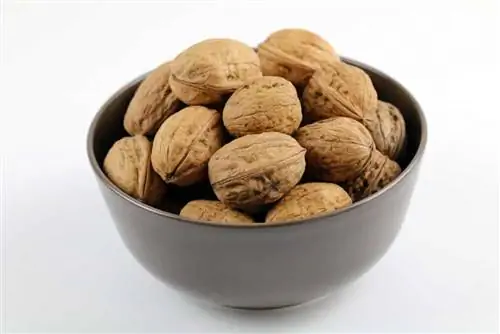
After the walnuts have dried, they can be stored. Walnuts are always stored hanging in bags or nets. This ensures even ventilation, which in turn prevents mold formation. Under no circumstances should walnuts be stored in plastic bags or bags. In addition, the following factors must be taken into account when storing walnuts:
- dry, dark place
- Humidity not too high
- relative humidity about 55-65%
- Temperature about 10-18 degrees
Note:
The dried walnuts can be stored this way for up to two years. If the nuts are particularly oily varieties, a shelf life of around one to one and a half years is possible.
Freeze walnuts
If you want to store walnuts, you don't necessarily have to dry them. Because freezing the nuts is also possible without any problems. What is practical here is that the nuts can be frozen whole or chopped and portioned. To do this, the nuts are first cleaned and the shells removed. The rest of the procedure is relatively simple and is as follows:
- place whole kernels on a baking tray
- or chop nuts
- Wrap the nuts in a kitchen towel
- and chop with a rolling pin or steak hammer
- Portion nuts if necessary
- pack airtight and freeze
- Nuts have a shelf life of about a year
The nuts are best portioned into 200 grams each, as this is the usual standard amount for many baking recipes.

